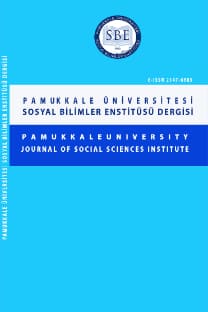İZLEYİCİLERİN POZİTİF VE NEGATİF DUYGULARININ LİDERİN HIZ VE ETKİLİLİĞİ ÜZERİNDEKİ ETKİSİ
THE EFFECT OF THE POSITIVE AND NEGATIVE EMOTIONS OF THE FOLLOWERS ON THE SPEED AND EFFECTIVENESS OF THE LEADER
___
- Attah, Y. Emmanuel, Obera, Victoria Ahonya ve Isaac, Sani (2017). Effective Leadership And Change Management for Sustainable Development in Nigeria, International Journal of Public Administration and Management Research (IJPAMR), 4(2): 37-42.
- Barsade, G. Sigal (2002). The Ripple Effect: Emotional Contagion and Its Influence on Group Behavior, Administrative Science Quarterly, 47(4): 644-675.
- Billings, Andy (2017). When Fast is too Slow: “Xcelerating” Leaders at Electronic Arts, People+Strategy, 40(3): 24-29.
- Bissell, Ben (2002). Resistance Fighters. California: Leadership.
- Boswell, H. Edwin, Davis, R. Jocelyn ve Frechette, M. Henry (2010). Strategic Speed, Harvard Business Publishing: USA.
- Brunner, Laurie (2013). Four Fundamentals of Revenue Growth. (28. 6. 2018) http://www.mainstreammanagement. com/pdf/four-fundamentals-of-revenue-growth.pdf
- Chai, Dae Seok, Jeong, Shinhee, Kim, Junhee, Kim, Sewon ve Hamlin, G. Robert (2016). Perceived Managerial And Leadership Effectiveness in A Korean Context: An Indigenous Qualitative Study, Asia Pac J Manag, 33: 789-820.
- Dabke, Deepika (2016). Impact of Leader’s Emotional Intelligence And Transformational Behavior on Perceived Leadership Effectiveness: A Multiple Source View, Business Perspectives And Research, 4(1): 27-40.
- Davis, R. Jocelyn, Frechette, M. Henry ve Boswell, H. Edwin (2010). The Need for Speed, New Zealand: Human Resources Magazine
- Edelman, J. Peter ve Knippenberg, Daan Van (2017). Training Leader Emotion Regulation and Leadership Effectiveness, J Bus Psychol, 32: 747-757.
- Enkavi, Ayşegül Horozoğlu (2013). Terfi ve Zam Alamadınız mı?. (6. 7. 2018) http://www.hurriyetaile.com/sizinicin/psikoloji/terfi-ve-zam-alamadiniz-mi_16589.html.
- Frackenpohl, Gerrit, Hillenbrand, Adrian ve Kube, Sebastian (2016). Leadership Effectiveness And Institutional Frames, Exp Econ, 19: 842-863.
- Gebremariam, Goitom Woldelibanos ve Delesa, Tesfa Mezgebu (2014). Assessment of Leadership Practices And Effectiveness In Ethiopian Universities, International Journal of Research in Commerce & Management, 5(7): 52-59.
- Goldring, B. Ellen, Mavrogordato, Madeline ve Haynes, Katherine Taylor (2015). Multisource Principal Evaluation Data: Principals’ Orientations And Reactions to Teacher Feedback Regarding Their Leadership Effectiveness, Educational Administration Quarterly, 51(4): 572-599.
- Gun, Jiajun, Xie, Fenghua ve Weng Derek Qingxiong (2012). Leadership, Team and Decision Speed: Empirical Study Using Cross-Provincial Data, Chinese Management Studies, 6(4): 598-608.
- Hamlin, G. Robert, Kim, Sewon, Chai, Dae Seok, Kim, Junhee ve Jeong, Shinhee (2016). Perceived Managerial And Leadership Effectiveness within South Korean And British Private Companies: A Derived Etic Comparative Study, Human Resource Development Quarterly, 27(2): 237-269.
- Hess, D. James ve Bacigalupo, C. Arnold (2013). Applying Emotional Intelligence Skills to Leadership and Decision Making in Non-Profit Organizations, Adm. Sci., 3: 202-220.
- Hopkins, Willie Edward ve Scott, G. Susanne (2015). Values-Based Leadership Effectiveness in Culturally Diverse Workplaces, Cross Cultural & Strategic Management, 23(2): 363-385.
- Kaya, Özlem, Özok, Ahmet Fahri, Özçalık, Fatih ve Akalp, Gizem (2015). Pozitif ve Negatif Duygusallığın Tasarım Birimi Çalışanları Üzerindeki Etkisi (Hazır Giyim Sektörü Örneği), Süleyman Demirel Üniversitesi Mühendislik Bilimleri ve Tasarım Dergisi, 3(3): 487-491.
- Koçel, Tamer (2015). İşletme Yöneticiliği. Beta Basım Yayım Dağıtım, 16. Baskı, İstanbul.
- Leng, Zongyang, Liu, Zhiying, Tan, Min ve Pang, Jiangang (2015). Speed Leaders And Quality Champions: Analyzing The Effect of Market Orientation And Technology Orientation Alignment on New Product Innovation, Management Decision, 53(6): 1247-1267.
- Liu, Wu, Song, Zhaoli, Li, Xian ve Liao, Zhenyu (2017). Why And When Leaders’ Affective States Influence Employee Upward Voice, Academy of Management Journal, 60(1): 238-263.
- Manasseh, Tumuhimbise (2015). Heightening Leadership Effectiveness In Local Governments of Uganda: ‘Challenge The Process’ for Organisational Support, International Journal of African Renaissance Studies, 10(2): 143-155.
- Nichols, Ellen (2009). Communications to Engage Light-Speed Leaders, Industrial And Commercial Training, 41(2): 102-105.
- Özdemir, Aytül Ayşe (2015). İş Tatmini, Pozitif/Negatif Duygulanım ve Yaşam Tatmininin Etkisi, Çalışma ve Toplum, 46(3): 47-61.
- Pearson, M. Christine (2017). The Smart Way to Respond to Negative Emotions at Work. (27. 6. 2018) http://ilp. mit.edu/media/news_articles/smr/2017/58305.pdf
- Rothman, B. Naomi Ve Melwani, Shimul (2017). Feeling Mixed, Ambivalent, And In Flux: The Social Functions Of Emotional Complexity For Leaders, Academy Of Management Review, 42(2): 259-282.
- Sağsan, Mustafa, Ertaş, Abdurrahman ve Burgul, Nazım Serkan (2016). Lider Antrenörlerin Bilgi Sahasında Deplasman Mücadelesi: KKTC Üzerine Görgül Bir Araştırma, Bilgi Dünyası, 17(1): 1-21.
- Tee, Eugene ve Ashkanasy, Neal (2006). Emotional Contagion from Followers to Leaders, and its Effect on Leadership Effectiveness and Speed, Anzam 2006 Conference, 6-10 Aralık, Australian and New Zealand.
- Wang, Zhenyuan, Chen, Xi ve Yu, Mingyang (2017). Interactive Effect of Leader–Member Tie And Network Centrality on Leadership Effectiveness, Social Behavior And Personality, 45(7): 1197-1210.
- Wasylkiw, Louise, Holton, Judith, Azar, Rima ve Cook, William (2015). The Impact of Mindfulness on Leadership Effectiveness in A Health Care Setting: A Pilot Study, Journal of Health Organization and Management, 29(7): 893-911.
- Watson, D., Clark, L.A. ve Tellegen, A. (1988). Development and Validation of Brief Measure of Positive and Negative Affect: The PANAS Scales, Journal of Personality and Social Psychology, 54(6): 1063-1070.
- Liu, Dong, Wong, Chi-Sum ve Fu, Ping Ping (2012). Team Leader’s Emotional Intelligence, Personality, and Empowering Behavior: An Investigation of their Relations to Team Climate, Advances in Global Leadership, 7: 71-97.
- Yılmaz, Tolga (2014). Lider Etkinliği Ölçeğinin Türkçeye Uyarlanması Çalışması, KSÜ Sosyal Bilimler Dergisi, 11(2): 1-24.
- Zenger, H. John ve Folkman, R. Joseph (2017). Tactics to Increase Leadership Speed, Leader to Leader, 2017(86): 23-28.
- ISSN: 1308-2922
- Yayın Aralığı: 6
- Başlangıç: 2008
- Yayıncı: Pamukkale Üniversitesi
YEŞİL SEGEDİK (GÖKÇE) KAYA MEZARLARI VE SURP KEVORK (KAHRAMAN SEGEDİK) KİLİSESİ
MİLLİ MÜCADELE DÖNEMİ’NDE DENİZLİ SAĞLIK HİZMETLERİ
İKİ ULUSUN HİKAYESİ: CHAUCER, HENRYSON, SHAKESPEARE, TROİLUS VE CRİSEYDE
ARAŞTIRMA VE GELİŞTİRME GİDERLERİNİN FİRMA KÂRLILIĞI ÜZERİNE ETKİSİ: BİST İMALAT SEKTÖRÜ ÖRNEĞİ
İZLEYİCİLERİN POZİTİF VE NEGATİF DUYGULARININ LİDERİN HIZ VE ETKİLİLİĞİ ÜZERİNDEKİ ETKİSİ
